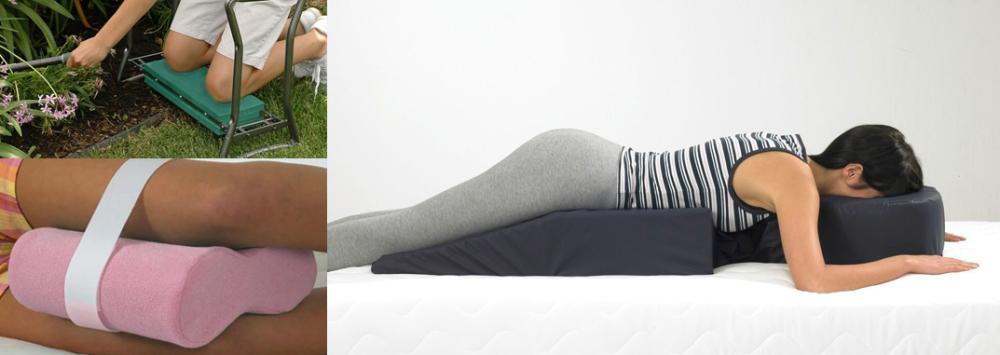
Handling the Changes Brought with Ageing Joints and Bones
Sally Madeley-Carr, OT18 Aug 2021
Arthritis stiffness and pain affects how we enjoy life.
Weakened joints, reduced grip and the accompanying build up of pain, are but a few of the changes our bodies incur with age.
Damaged cartilage, loose ligaments and inflamed connective tissue (synovium) can cause stiffness and pain in joints, making completing daily tasks quite a feat.
When the cartilage in the joint starts to wear down, the constant rubbing together of the bones can cause the bones to change shape.
A slight change to the norm can make jobs more difficult and cause a rethink on how to perform particular tasks. Looking after our joint health can both lessen and delay onset of stiffness and pain.
Osteoarthritis and Osteoporosis
Osteoarthritis shows itself as inflammation and deterioration of the joints. In the UK, around five million people have some level of knee arthritis.
Osteoarthritis is the most common form of arthritis.
Osteoporosis shows itself as broken bones, which can occur from a fall of less than standing height. In the UK, over three million people have osteoporosis.
Hands
Arthritis in the hands usually starts between the ages of thirty and fifty, though it can start earlier.
Dull pain and burning are common early symptoms, though the skin disease, psoriasis, is also an early indicator. Other symptoms include stiffness, numbness and tingling.
-How to Help Yourself
When and where possible, push items rather than lift them.
If you have reduced strength in your hands, try to reduce necessary grip needed on items e.g. use wider (or cushioned) cutlery handles, so a holding grip can be reached with less pressure.
When lifting heavy or bulky items, use the palms of your hands and not just your fingers.
Doing hand exercises in warm water can help make the exercises easier and can reduce pain. Adding a quarter of a cup of Epsom salts to a bowl of warm water can help reduce swelling.
Applying something cold (e.g. ice cubes) will both reduce swelling and numb the area.
Applying something hot (e.g. a hot water bottle) will increase circulation and flexibility, as well as loosen up the muscles.
Legs
Leg pain can refer to pain anywhere between your pelvis and your foot.
Arthritis in the leg can show itself as swollen joints, weakness in the joints and muscles, a change in walking comfort and style, rashes and skin changes, as well as a reduced range of motion.
Osteoarthritis is caused by normal wear and tear but can also be brought on by injury or infection to the joints.
- How to Help Yourself
Look at the ergonomics (layout) of your home and work towards reducing foot fall. For example:-
- designate one kitchen cupboard and part of the worktop to things you use most often - this will cut down on walking and so reduce stress on the hip, knee,and feet joints.
- plan what jobs need to be done upstairs and reduce going up and down stairs to a minimum.
- try not to stand in the same position for too long a period, as this will affect your knee joints, which will be bearing the brunt of your full weight.
Excess weight bears heavily on joints, particularly the hips, knees and feet joints, as they have to endure the extra pressure when you are standing or walking.
Feet
A human foot contains more than thirty joints.
Osteoarthritis affects the feet in one in six of people who are aged over fifty.
Osteoarthritis often affects the big toe joint and this is sometimes referred to as gout.
- How to Help Yourself
Wear sensible footwear. Look for:-
- room for your toes to move comfortably
- bendable rubber soles, as these soles give cushioning to your feet
- shoes or boots that are flat soled, or only house a small heel, allowing pressure to be placed evenly over the whole of the foot, rather than forced onto the toes.
Overall Care
Understand pain - when performing a task, if you feel pain starting to present itself, take a break before the pain becomes full on.
Losing weight will significantly reduce your chances of getting osteoarthritis in the knees.
Give joints a break from activity, by changing to another task which does not involve the same joints.
Rather than rushing, spend a little longer on tasks - break a job up into several parts by taking breaks away from it, so as to stop pain creeping in.
In the kitchen, locate most used items within easy reach - this will cut down on moving around and possible falls.
Not using muscles can cause them to waste away - regular exercise strengthens the muscles around your joints, helping you to retain a range of movements, as well as prevent stiffness and pain.
Cut down on smoking - smoking can have a negative effect on bone mass, which may lead to osteoporosis. Nicotine slows down the creation of the cells which form bone and so slow down the healing process.
What to Consume and What Not To
You are what you eat and knowing what to eat and what to avoid can make a big difference to how you experience arthritis pain.
Amongst other healthy foods:-
Enjoy:-
- oranges (fresh fruit or juice), as vitamin C can stave off the progression of osteoarthritis
- bananas - high in magnesium and potassium, bananas can alleviate arthritis pain and inflammation and also increase bone density
- pineapple - this fruit is rich in vitamin D and is said to reduce pain and swelling in osteoarthritis
- green vegetables and herbs, such as kale, spinach, broccoli and parsley, all contain high levels of calcium and so can slow down bone loss and cartilage damage
- grains, pulses and nuts, poultry and oily fish - these food choices can reduce inflammation and pain.
Avoid:-
- sugar - this processed ingredient can increase joint and muscle inflammation
- coffee -the boost that coffee can give you to start off the day is not the best start, as too much caffeine can weaken your bones
- excessive alcohol - alcohol disrupts normal gut functioning and can cause inflammation
- saturated fats - these fats increase inflammation and also heighten the risk of heart disease
- processed foods and takeaways, as these are heavy in processed sugar and fats.
How Does Exercise Fit in with Living with Arthritis?
Not using joints doesn't help the problem. Exercise does.
Swimming and other aquatic exercises allow you to exercise the joints whilst having no weight on them.
Stretching exercises make you use muscles you may not use very often and will help maintain ligament health. Consider yoga as a beneficial pastime, for both physical and mental health.
Alternate between sitting and standing, as prolonged periods of either will lead to stiffness and pain.
Medical Intervention
Over-the-counter medication, such as aspirin, ibuprofen and naproxen, can successfully reduce the pain and swelling which comes with osteoarthritis.
Voltaron gel may be recommended, as this treatment has fewer side-effects than aspirin, ibuprofen and naproxen.
Steroids like cortisone are powerful in reducing pain and inflammation. Doctors may agree to a round of three injections, a break from this treatment then needed before another round will be given.
Surgery is also an option, though this is if all other treatments don't provide solutions.
Surgery would involve fusing two bones together, or joint replacement.
Your GP will need to advise you should you be considering any medical treatment.
How to Handle Present Pain
Some arthritis medications can affect the skin, leading to bruises, bumps and lesions.
Whilst trying to manage arthritis by conventional methods, there are also some useful products which can both alleviate pain and protect joints.
- Knee Cushions
When you sleep, arthritis pain seems to be more noticeable, as the body is not truly aligned (not in a straight line).
Knee cushions (knee pillows) are designed to align the spine and to adjust the legs and knees into a more comfortable position for sleeping or relaxing.
Body alignment improves blood flow and so more nutrients are sent to where they are needed, which reduces pain.
- Body Protectors
Protecting skin is of vital importance to good health.
With age, the cells which make up the layers of our skin reduce in size and number and the fatty layer under the skin reduces, giving us less cushioning from the impact of daily life.
Different types of arthritis can affect the skin in different ways e.g. rashes, lesions and torn skin.
Body protectors for the skin cover the frail surface and provide much needed cushioning to prevent tears.
Full leg sleeves can protect frail skin and also stop knees rubbing together when walking.
Full arm sleeves can protect thin and frail skin from tearing.
Summary
Smoking has a serious negative effect on bone healing and so contributes to the onset of osteoporosis.
Before taking a regular dose of aspirin, ibuprofen or naproxen, consult your doctor first, as there can be a risk to cardiovascular health.
If you are not getting enough appropriate vitamins in your diet to promote strong bones, take multivitamins to supply you with calcium, vitamins C, E and K, as well as folic acid.
If you experience arthritis pain, don't later attribute any new pains to arthritis, as well. Always seek the advice of your doctor, as pain can come from other health conditions and diagnosis should always be sought in the early stages.
Body protectors can give extra support and protection where needed.
Regular exercise strengthens the muscles around your joints, helps you to retain a good range of movements and can prevent stiffness and pain.

Sally Madeley-Carr, OT
Sally qualified as an Occupational Therapist in 1996 and is a well-respected professional in the field of rehabilitation equipment and living aids. She has worked in private practice and within the NHS, developing a broad experience with adults and children. Click here for Sally's registration with the Health and Care Professions Council. The HCPC regulates health, psychological and social work professionals in the UK.